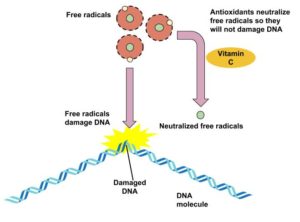Chapter 10. Vitamins
Antioxidants
The market is flooded with advertisements for “super antioxidant” supplements teeming with molecules that block free radical production, stimulate the immune system, prevent cancer, and reduce the signs of aging. Based on the antioxidant-supplement industry’s success, the general public appears to believe these health claims. However, these claims are not backed by scientific evidence; rather, there is some evidence suggesting supplements can actually cause harm. While scientists have found evidence supporting the consumption of antioxidant-rich foods as a method of reducing the risk of chronic disease, there is no “miracle cure”; no pill or supplement alone can provide the same benefits as a healthy diet. Remember, it is the combination of antioxidants and other nutrients in healthy foods that is beneficial. In this section, we will review how particular antioxidants function in the body, learn how they work together to protect the body against free radicals, and explore the best nutrient-rich dietary sources of antioxidants. One dietary source of antioxidants is vitamins. In our discussion of antioxidant vitamins, we will focus on vitamins E, C, and A.
Figure 10.21 Antioxidants Role

Antioxidant Chemicals Obtained from the Diet
There are many different antioxidants in food, including selenium, which is one of the major antioxidants. However, the antioxidants you may be the most familiar with are vitamins. The “big three” vitamin antioxidants are vitamins E, A, and C, although it may be that they are called the “big three” only because they are the most studied.
Table 10.32 Some Antioxidants Obtained from Diet and Their Related Functions
| Antioxidant | Functions Attributed to Antioxidant Capacity |
| Vitamin A | Protects cellular membranes, prevents glutathione depletion, maintains free radical detoxifying enzyme systems, reduces inflammation |
| Vitamin E | Protects cellular membranes, prevents glutathione depletion |
| Vitamin C | Protects DNA, RNA, proteins, and lipids, aids in regenerating vitamin E |
| Carotenoids | Free radical scavengers |
| Lipoic acid | Free radical scavenger, aids in regeneration of vitamins C and E |
| Phenolic acids | Free radical scavengers, protect cellular membranes |

